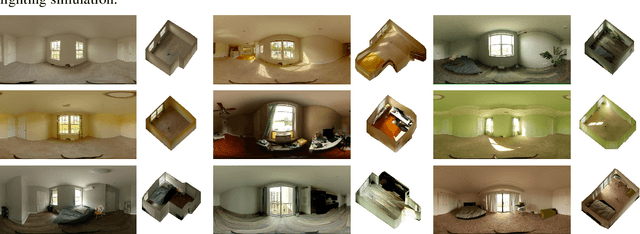Guanzhou Ji
Indoor Light and Heat Estimation from a Single Panorama
Feb 10, 2025



Abstract:This paper presents a novel application for directly estimating indoor light and heat maps from captured indoor-outdoor High Dynamic Range (HDR) panoramas. In our image-based rendering method, the indoor panorama is used to estimate the 3D room layout, while the corresponding outdoor panorama serves as an environment map to infer spatially-varying light and material properties. We establish a connection between indoor light transport and heat transport and implement transient heat simulation to generate indoor heat panoramas. The sensitivity analysis of various thermal parameters is conducted, and the resulting heat maps are compared with the images captured by the thermal camera in real-world scenarios. This digital application enables automatic indoor light and heat estimation without manual inputs and cumbersome field measurements.
Evaluating Panoramic 3D Estimation in Indoor Lighting Analysis
Mar 21, 2024



Abstract:This paper presents the use of panoramic 3D estimation in lighting simulation. Conventional lighting simulation necessitates detailed modeling as input, resulting in significant labor effort and time cost. The 3D layout estimation method directly takes a single panorama as input and generates a lighting simulation model with room geometry and window aperture. We evaluate the simulation results by comparing the luminance errors between on-site High Dynamic Range (HDR) photographs, 3D estimation model, and detailed model in panoramic representation and fisheye perspective. Given the selected scene, the results demonstrate the estimated room layout is reliable for lighting simulation.
View-Based Luminance Mapping in Open Workplace
Nov 25, 2023



Abstract:This paper introduces a novel computational method for mapping indoor luminance values on the facade of an open workplace to improve its daylight performance. 180-degree fisheye renderings from different indoor locations, view positions, and times of the year are created. These renderings are then transformed from two-dimensional (2D) images into three-dimensional (3D) hemispheres. High luminance values are filtered and projected from the hemisphere to the facade surface. This framework will highlight the areas of the facade that allow too much light penetration into the interior environment. The flexible workflow allows occupant centric lighting analysis that computes multiple design parameters and synthesizes results for localized facade optimization and daylight design.
Virtual Home Staging: Inverse Rendering and Editing an Indoor Panorama under Natural Illumination
Nov 21, 2023Abstract:We propose a novel inverse rendering method that enables the transformation of existing indoor panoramas with new indoor furniture layouts under natural illumination. To achieve this, we captured indoor HDR panoramas along with real-time outdoor hemispherical HDR photographs. Indoor and outdoor HDR images were linearly calibrated with measured absolute luminance values for accurate scene relighting. Our method consists of three key components: (1) panoramic furniture detection and removal, (2) automatic floor layout design, and (3) global rendering with scene geometry, new furniture objects, and a real-time outdoor photograph. We demonstrate the effectiveness of our workflow in rendering indoor scenes under different outdoor illumination conditions. Additionally, we contribute a new calibrated HDR (Cali-HDR) dataset that consists of 137 calibrated indoor panoramas and their associated outdoor photographs. The source code and dataset are available: https://github.com/Gzhji/Cali-HDR-Dataset.
 Add to Chrome
Add to Chrome Add to Firefox
Add to Firefox Add to Edge
Add to Edge